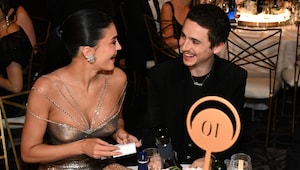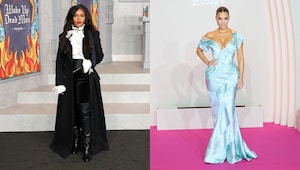Dia Mirza is Pushing For a Sustainable New World
For actor Dia Mirza, being ‘ECO-CONSCIOUS‘ is more than a TRENDY buzzword—it is the LIFE she has been living and pushing for, for decades. She talks about it all to Cosmo Ed Nandini Bhalla.

The greatest testimony to our covergirl‘s passion for the environment comes from the changes she has brought into her own life—Dia is an anti-plastic advocate, and has galvanised family, staff, friends, and neighbours to rethink their water, electricity, energy, and everyday lifestyle choices. At the Cosmo covershoot, incidentally, the actor carefully scrutinised each garment on the styling rack, before giving it a ‘sustainable’ nod of approval. “We are confronted by an existential crisis,” she tells me later, her voice imbued with significance. “The way we have built the world, the way we have created patterns of consumption and economies, it’s simply not sustainable. The Earth is running out of resources, and we won’t be left with clean air, clean water, or the kind of climate that is necessary to grow food. We just have this decade to fix what we have done wrong. This pandemic should have been our biggest wake-up call, because if we don’t change the way we live our lives, things will only get worse.”
Read on as Dia explains the link between our health and that of the planet (“when we disrupt the balance of the environment, we are causing ill health and misfortune to ourselves,” she says); addresses the subject of conscious consumption, and tells anyone who will listen that the fight against environmental destruction can no longer be ignored...
Nandini Bhalla: Was it tough, convincing family and friends to make conscious changes in their lives?
Dia Mirza: “Initially, training my house help, driver, and those involved with grocery shopping, wasn’t easy...but it happened. Now, it’s like clockwork. Everyone in this house knows that we do not accept plastic bags. Later, I also popularised the travelling bottle—wherever I’d go, my metal bottles would come with, and I would refill them wherever I was. At first, people thought I was completely nuts. They were like, ‘You’re going to walk on the red carpet or sit in an auditorium with your travelling bottle?!’ And I‘d say, ‘Yes I am, because I need water and I refuse to drink from plastic bottles.’ And I talk about these changes constantly, even at the cost of repeating myself, because every time a new person hears about them, they’re like, ‘Oh, if she can do it, I can do it, too. I never saw the plastic in my life, but now that she is pointing it out, I should make a shift.’
Then, of course, there’s the very important subject of managing our waste. So, I compost and segregate waste at home. I ensure the waste gets collected, segregated (especially the PVCs and plastics they come in), and disposed off to the right vendor, so it doesn’t just end up in a landfill. All our kitchen waste goes to the building vendors who make use of the compost for our beautiful gardens. We have also put in place a water-check system, which guages the level of the water and ensures there is never any wastage. I’m certain we have saved thousands of litres of water by just installing this one system, so that‘s a big win.
During the summer months, we elect different people from the neighbourhood, for different things. We don’t allow more than a bucket of water to be used to wash a car. And there’s this fun competition that we organise—each month, we compare electricity bills, and the person with the lowest bill gets a little gift. I am often surprised to learn of friends with electricity bills that run into 20,000-30,000 rupees a month. In my society, our electricity bills do not exceed 5,000 rupees.
I always encourage people to give some thought to what they eat, what they wear, and the kind of make-up or personal hygiene products they use. When purchasing things, it’s important to question how sustainable the company is, what kind of environment they manufacture in, and where the ingredients come from. That should help you decide what you want to use, what you want to eat, what you want to wear. The simple mantra is to eat local and buy local.”

Jacket and pants, both Rahul Mishra; crop top, Aroka; necklace, Razwada Jewels; shoes, Charles & Keith
NB: And how have your fashion choices changed?
DM: “It’s unfortunate that the fashion industry is one of the biggest polluters on the planet. But one of the first things each one of us can take responsibility for is our consumption—when we consume less, we reduce our carbon footprint. I admit that when I was younger, and I just started to make money, I wanted to buy everything...all the latest things! I would shop like there was no tomorrow, and this endless cycle of need and greed came to a grinding halt when I discovered how many thousands of litres of water were used just to make a simple pair of jeans. How, in a pair of stretch jeans, the plastic stays for 1,000 years, even after the cotton in the jeans has decomposed.
When you learn about these things, you just start consuming less. One of the things that I’ve learnt to do is to only buy things that I absolutely need. I make sure that none of my clothes end up in landfills. As Indians, we have this wonderful culture of passing things on, so I have successfully done that over the years.
One of the most important thing in sustainable fashion is to buy and empower brands that care about sustainability. So, using garments that are dyed in chemical-free dye, where the textile is natural, where the work environment and manufacturing is done in a sustainable manner, where old crafts are carried forward, and people’s lives are empowered in doing so. I think India is an incredible country with diversity of craft and sustainable textiles. And it gives me great joy and a sense of relief to see how so many designers are seriously focusing on sustainability, down to even ensuring that their tags are not made with horrible plastic links, but with a thread of waste fabric or rope. I think India has the brightest future when it comes to sustainable fashion, because we know how to live in harmony with nature. We‘ve known it for thousands of years, we just have to remember and keep doing it.”
NB: What are some of the simple things each one of us can do, to reduce our carbon footprint?
DM: “Refuse all single-use plastics; carry your own bottle; carry your own bag; take five-minute baths or less; adopt a mostly plant-based diet; turn off the mains of all appliances when they are not in use; switch off the lights when you leave a room; conserve energy; waste less; eat local, buy local, and support local!
The changes I’ve made in my life, they didn’t happen overnight. They were made over a period of time. So, if you really care about what‘s happening to the planet, you can start by changing just one thing. And once that one thing becomes a part of your daily life, you can choose another.”

Trousers, blazer and trench coat, all Doodlage; boots, Christian Louboutin; earrings, Roma Narsinghani
NB: And what are some of the government policy changes that we need to see?
DM: “The good news is that India has signed the Paris agreement, we have adopted sustainable development goals, and we are making all the right commitments—but those commitments need to start reflecting in every single policy that is being drafted. That change will only come when citizens proactively get involved and demand their implementation. I believe the victory of the Aarey Forest being declared a ‘forest cover’ happened because of ‘people power’. There are more people in government policy today who understand that things need to change...and if those changes don’t happen, then it’s on you and me to ask the right questions and demand the changes. India occupies just 2.3% of the geographical landmass of the planet but is home to the second largest population—we need our natural resources, but our water, air, and good soil is being reduced due to concepts of ‘growth’ and ‘development’. So, if each one of us can find ways to grow more trees, to ensure our government has stronger policies for environmental and forest protection, to start empowering and supporting organisations that do this work on our behalf...it would make a big difference.”
NB: What are your plans for the future?
DM: “I’m driven by purpose and I love my craft... I love being an actor, I love being a producer, and I hope to be able to use the power of storytelling and the creative arts to bring change and positively impact people‘s lives.”
Credits:
Creative Direction: Zunaili Malik
Hair: Hiral Bhatia;
Make-Up: Divya Chablani;
Styling: Pranay Jaitly and Shounak Amonkar at Who Wore What When;
Production: P Productions
more from Celebrity

The truth behind the viral 'Kylie Jenner-Chalamet' name card at Golden Globes 2026

Same trousers, same top cut—how the repeat silhouette is turning outfits into personal uniforms

These cosy cardigans will help you tap into the "granny chic" trend

'Heated Rivalry' season 2 is coming—and here’s what the books promise

BTS is back on tour—but seems like India missed a stop

How snack tourism is turning sightseeing into bite-sized adventures

From sleepwear to swim wear, India’s experiencing a rise in homegrown brands

Why spending time with your girlfriends is the best form self-care

The most memorable moments from the Golden Globes 2026 awards night

The most flattering blush placement for every face shape
